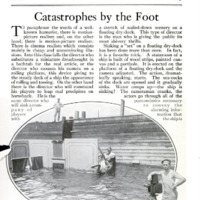Photographic Eye for the Airmen
Item
-
Title (Dublin Core)
-
Photographic Eye for the Airmen
-
Article Title and/or Image Caption (Dublin Core)
-
Photographic Eye for the Airmen
-
Caption: With this camera apparatus every detail of the world below the airman is minutely registered
on the roll of film which runs over the camera lens at a speed regulated by the operator
-
extracted text (Extract Text)
-
GREATER progress has been made
in aerial photography during the
present war than in the years fol-
lowing 1858, when M. Nadar, of Paris,
took a view of that city by means of a
camera attached to the basket of a bal-
loon. The fact that a photograph from
an aeroplane of fortifications, damaged
railways, bodies of troops, and the con-
tour of the enemy's country gives valu-
able information which is absolutely
reliable, not being dependent for its
accuracy on the skill and coolness of the
observer, makes this form of reconnais-
sance of the highest military importance.
Indeed, it is of such value that a dozen
different types of aerial photographing
apparatus have been evolved in the
short duration of the present world strug-
gle. The latest development is found in
the Fabbri automatic aeroplane camera,
which includes some features already
tried out by other inventors but which is,
in the main, an ingenious mechanism of
original construction. With it an aerial
scout can take a continuous photograph
of the earth's surface one hundred and
thirty miles long. When operated on an
aeroplane at an altitude of two thousand
feet it will take into its field a strip of
ground one thousand two hundred feet
wide. In clear weather excellent work
can be done at four thousand feet, in
which case the width of the field is about
two thousand, four hundred fect.
Suppose a ‘scout is given orders to
photograph the entire territory occupied
by the enemy. He regulates his camera,
soars aloft, and when over the enemy's
trenches at an altitude of two thousand
fect, for instance, turns a lever which
releases a propeller in front of a gear box,
which, in turn, starts the camera mechan
ism in motion. Instantly he obtains a
continuous. photograph of the earth's
surface one thousand, two hundred feet
wide.
Should he desire to get more useful
information by continuing his flight at a
higher altitude, he stops the camera
mechanism and ascends to twice the
height. There he makes a readjustment
of the apparatus and continues his
fight, taking a continuous photograph
meantime. Mile after mile he continues,
until, if he so wishes, he can obtain a
photographic record of one hundred and
thirty miles of the enemy's territory.
Briefly, the camera consists of a camera
box containing two rollers round which
the film is carried. ‘The film has a
series of perforations along one edge, and
a toothed stop is provided to engage
with these and hold the film motionless
when required. The box is impervious
to light, and has a lens pointing down-
Ward, through which the mai. photo-
graph is taken. Tt has also another lens
pointing directly upward, which pro-
duces photographs at desired intervals
of the exact position of the compass and
aneroid needles situated in the holding
case above. This last-named photograph
automatically registers. on dhe Tim the
direction and altitude of the
aeroplane when the exposure
was made.
The film rollers are driven
by a propeller through the
gear box. The hand lever
controls the intervals of ex-
posure by varying the speed
of the shaft as compared
with that of the propeller.
The shaft may be operated
by hand through the lever
and a single photograph be
taken, the propeller being for
the moment put out of gear.
-
Language (Dublin Core)
-
eng
-
Date Issued (Dublin Core)
-
1916-08
-
pages (Bibliographic Ontology)
-
202-203
-
Rights (Dublin Core)
-
Public Domain (Google digitized)
-
Archived by (Dublin Core)
-
Filippo Valle
-
Alberto Bordignon (Supervisor)
 Popular Science Monthly, v. 89, n. 2, 1916
Popular Science Monthly, v. 89, n. 2, 1916



